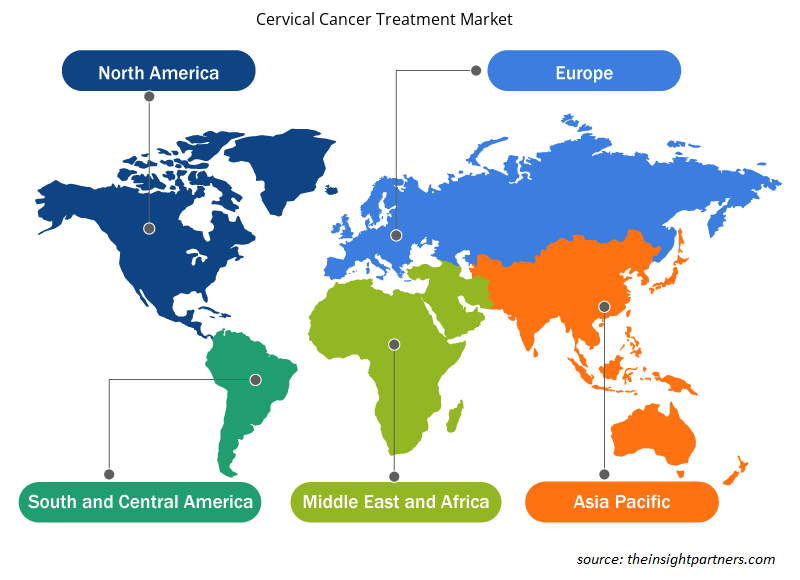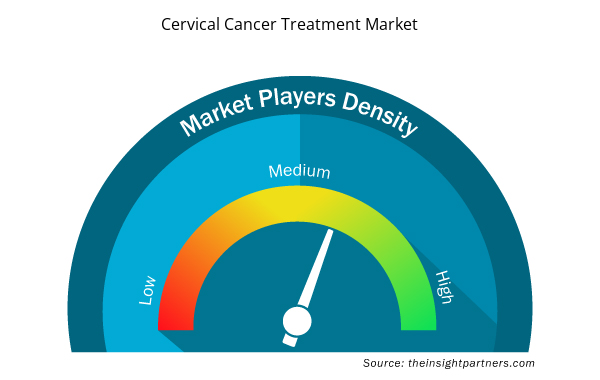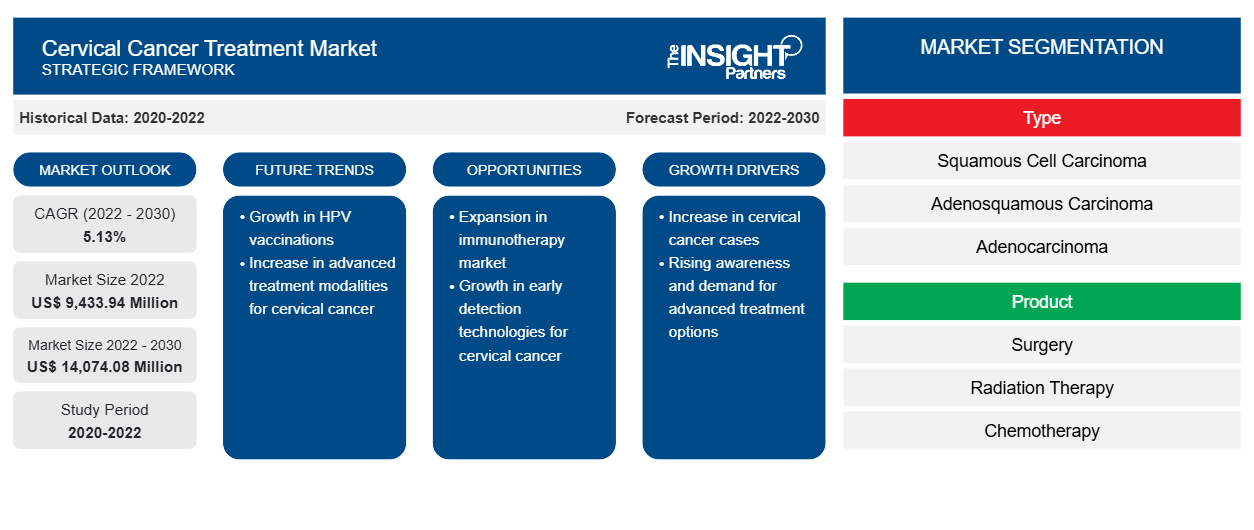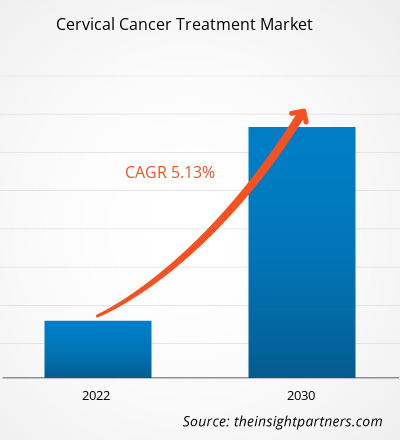[Forschungsbericht] Der Markt für die Behandlung von Gebärmutterhalskrebs soll von 9.433,94 Millionen US-Dollar im Jahr 2022 auf 14.074,08 Millionen US-Dollar im Jahr 2030 wachsen; es wird erwartet, dass der Markt von 2022 bis 2030 eine durchschnittliche jährliche Wachstumsrate von 5,13 % verzeichnet.
Markteinblicke und Analystenansichten:
Die Marktprognose für die Behandlung von Gebärmutterhalskrebs kann Beteiligten bei der Planung ihrer Wachstumsstrategien helfen.
Gebärmutterhalskrebs ist eine Krebserkrankung, die in den Zellen des Gebärmutterhalses auftritt, also im unteren Teil der Gebärmutter, der mit der Vagina verbunden ist. In 90 % der Fälle entstehen Gebärmutterhalskrebserkrankungen aufgrund einer HPV-Infektion und werden durch einen Abstrich diagnostiziert. Die zunehmende Verbreitung von Gebärmutterhalskrebs und die Zunahme von HPV-Infektionen sind die Hauptfaktoren, die das Wachstum des Marktes für die Behandlung von Gebärmutterhalskrebs vorantreiben. Allerdings behindert das mangelnde Bewusstsein für die Diagnose- und Behandlungsmethoden das Wachstum des Marktes. Zu den Markttrends für die Behandlung von Gebärmutterhalskrebs gehört die zunehmende Forschung und Entwicklung im Bereich der Diagnose und Behandlung von Gebärmutterhalskrebs.
Wachstumstreiber und Herausforderungen:
Die zunehmende Prävalenz von Gebärmutterhalskrebs treibt den Markt für die Behandlung von Gebärmutterhalskrebs an
Krebs wird weltweit zu einer der Haupttodesursachen. Laut der Weltgesundheitsorganisation (WHO) war Krebs 2019 in 183 Ländern die häufigste Todesursache für Personen unter 70 Jahren, während er in 123 anderen Ländern die vierthäufigste Todesursache weltweit war. Darüber hinaus waren laut den im März 2021 von der Weltgesundheitsorganisation veröffentlichten Daten im Jahr 2020 fast 10 Millionen Todesfälle auf verschiedene Krebsarten zurückzuführen. Der betrachtete Markt hat ein erhebliches Wachstum gezeigt, das mit der steigenden Häufigkeit von Gebärmutterhalskrebs bei Frauen weltweit in Verbindung gebracht werden kann. Laut der Weltgesundheitsorganisation (WHO) sterben jedes Jahr mehr als 270.000 Frauen an Gebärmutterhalskrebs. Die Sterberaten bei Gebärmutterhalskrebs sind in ärmeren Ländern aufgrund der späten Entdeckung der Krankheit hoch.
Die zunehmende Verbreitung von Gebärmutterhalskrebs belastet die Gesundheitssysteme weltweit. Nach Angaben der Internationalen Agentur für Krebsforschung (IARC) wird die weltweite Belastung durch neue Krebsfälle auf etwa 27,5 Millionen geschätzt, und die Krankheit wird bis 2040 voraussichtlich etwa 163 Millionen Todesfälle verursachen. Faktoren wie Lebensstiländerungen, Rauchen, verringerte körperliche Aktivität sowie unsichere Gesundheits- und Klimabedingungen werden die Krebsbelastung in der Welt in den kommenden Jahren voraussichtlich erhöhen. Daher ist es von entscheidender Bedeutung, die weltweit steigende Zahl von Krebserkrankungen unter Kontrolle und zu verhindern.
Mangelndes Bewusstsein für Gebärmutterhalskrebs in der Bevölkerung, bei Gesundheitsdienstleistern und politischen Entscheidungsträgern, begrenzter Zugang zu hochwertigen Gesundheitsdiensten und Gebärmutterhalskrebs-Screening-Programmen und fehlende funktionierende Überweisungssysteme sind einige der Faktoren, die zur hohen Inzidenz und Mortalität von Gebärmutterhalskrebs führen. Aufgrund eines verbesserten Zugangs zu zytologischen Screenings und einer schnellen Behandlung früher Gebärmutterhalsläsionen sind die Inzidenz und Mortalität von Gebärmutterhalskrebs in Industrieländern gesunken. Um die Mortalität durch Gebärmutterhalskrebs zu senken, ist es entscheidend, bevölkerungsweite Gebärmutterhalskrebs-Screenings einzuführen und ihre Akzeptanz in Ländern mit niedrigem und mittlerem Einkommen (LMICs) zu erhöhen. Die Sensibilisierung für Risikofaktoren wie den ersten Geschlechtsverkehr in jungem Alter und mehrere männliche Sexualpartner, das hohe Risiko in Zusammenhang mit den HPV-Typen 8, 9 und 10, die erste voll ausgetragene Schwangerschaft in jungem Alter, die langfristige Einnahme oraler Verhütungsmittel und HIV-Infektionen kann dazu beitragen, die Teilnahme an Screening-Programmen zu erhöhen. Ein besseres Bewusstsein für die Symptome von Gebärmutterhalskrebs, wie z. B. Vaginalblutungen zwischen den Menstruationen, Vaginalblutungen nach der Menopause, Vaginalblutungen nach dem Geschlechtsverkehr, übelriechender Vaginalausfluss und Schmerzen im Unterleib, könnte Frauen dabei helfen, frühzeitig Hilfe zu suchen. Das mangelnde Bewusstsein für Gebärmutterhalskrebs in der Bevölkerung behindert also das Wachstum des Marktes für die Behandlung von Gebärmutterhalskrebs.
Passen Sie diesen Bericht Ihren Anforderungen an
Sie erhalten kostenlos individuelle Anpassungen an jedem Bericht, einschließlich Teilen dieses Berichts oder einer Analyse auf Länderebene, eines Excel-Datenpakets sowie tolle Angebote und Rabatte für Start-ups und Universitäten.
- Holen Sie sich die wichtigsten Markttrends aus diesem Bericht.Dieses KOSTENLOSE Beispiel umfasst eine Datenanalyse von Markttrends bis hin zu Schätzungen und Prognosen.
Berichtssegmentierung und -umfang:
Segmentanalyse:
Nach Typ ist der Markt in Plattenepithelkarzinom, Adenosquamöskarzinom und Adenokarzinom segmentiert. Das Segment Plattenepithelkarzinom hatte 2022 einen größeren Marktanteil bei der Behandlung von Gebärmutterhalskrebs und wird voraussichtlich zwischen 2022 und 2030 eine höhere CAGR verzeichnen. Nach Produkt wird der Markt in Chirurgie, Strahlentherapie , Chemotherapie, Immuntherapie und therapeutische Impfstoffe unterteilt. Es wird erwartet, dass das Segment Chirurgie bis 2030 einen bedeutenden Anteil halten wird. In Bezug auf den Endverbraucher ist der Markt in Krankenhäuser, häusliche Pflege, Krebszentren und andere unterteilt. In Bezug auf den Endverbraucher hatte das Krankenhaussegment 2022 den größten Marktanteil bei der Behandlung von Gebärmutterhalskrebs.
Regionale Analyse:
Geografisch umfasst der Bericht über den Markt für die Behandlung von Gebärmutterhalskrebs Nordamerika, Europa, den asiatisch-pazifischen Raum, den Nahen Osten und Afrika sowie Süd- und Mittelamerika. Nordamerika hatte 2022 den größten Marktanteil bei der Behandlung von Gebärmutterhalskrebs. In Nordamerika haben die USA einen bedeutenden Anteil. Ständig laufende F&E-Aktivitäten, finanzielle Unterstützung durch Regierungen und andere öffentliche und private Organisationen, Partnerschaften zwischen IT- und Pharmaunternehmen und die steigende Zahl neurologischer Erkrankungen treiben das Marktwachstum im Land in erster Linie an. Darüber hinaus wird erwartet, dass strategische Initiativen der Regierung zur Verbesserung der Testverfahren dem Markt im Prognosezeitraum zugute kommen. Die zunehmende Einführung von Vorschriften in Bezug auf seltene Krankheiten wird höchstwahrscheinlich eine Gelegenheit zur Markterweiterung bieten. So hat beispielsweise die American Cancer Society (ACS) im September 2020 die Standards für das Screening auf Gebärmutterhalskrebs überarbeitet.
Regionale Einblicke in den Markt für die Behandlung von Gebärmutterhalskrebs
Die regionalen Trends und Faktoren, die den Markt für die Behandlung von Gebärmutterhalskrebs im Prognosezeitraum beeinflussen, wurden von den Analysten von Insight Partners ausführlich erläutert. In diesem Abschnitt werden auch die Marktsegmente und die Geografie der Behandlung von Gebärmutterhalskrebs in Nordamerika, Europa, im asiatisch-pazifischen Raum, im Nahen Osten und Afrika sowie in Süd- und Mittelamerika erörtert.

- Erhalten Sie regionale Daten zum Markt für die Behandlung von Gebärmutterhalskrebs
Umfang des Marktberichts zur Behandlung von Gebärmutterhalskrebs
| Berichtsattribut | Details |
|---|---|
| Marktgröße im Jahr 2022 | 9.433,94 Millionen US-Dollar |
| Marktgröße bis 2030 | 14.074,08 Millionen US-Dollar |
| Globale CAGR (2022 - 2030) | 5,13 % |
| Historische Daten | 2020-2022 |
| Prognosezeitraum | 2022–2030 |
| Abgedeckte Segmente | Nach Typ
|
| Abgedeckte Regionen und Länder | Nordamerika
|
| Marktführer und wichtige Unternehmensprofile |
|
Dichte der Marktteilnehmer für die Behandlung von Gebärmutterhalskrebs: Auswirkungen auf die Geschäftsdynamik verstehen
Der Markt für Behandlungen von Gebärmutterhalskrebs wächst rasant, angetrieben durch die steigende Nachfrage der Endnutzer aufgrund von Faktoren wie sich entwickelnden Verbraucherpräferenzen, technologischen Fortschritten und einem größeren Bewusstsein für die Vorteile des Produkts. Mit steigender Nachfrage erweitern Unternehmen ihr Angebot, entwickeln Innovationen, um die Bedürfnisse der Verbraucher zu erfüllen, und nutzen neue Trends, was das Marktwachstum weiter ankurbelt.
Die Marktteilnehmerdichte bezieht sich auf die Verteilung der Firmen oder Unternehmen, die in einem bestimmten Markt oder einer bestimmten Branche tätig sind. Sie gibt an, wie viele Wettbewerber (Marktteilnehmer) in einem bestimmten Marktraum im Verhältnis zu seiner Größe oder seinem gesamten Marktwert präsent sind.
Die wichtigsten auf dem Markt für die Behandlung von Gebärmutterhalskrebs tätigen Unternehmen sind:
- F. Hoffmann-La Roche Ltd
- Merck Sharp
- Dohme Corp.
- GlaxoSmithKline plc.
- Genentech, Inc.
Haftungsausschluss : Die oben aufgeführten Unternehmen sind nicht in einer bestimmten Reihenfolge aufgeführt.

- Überblick über die wichtigsten Akteure auf dem Markt für die Behandlung von Gebärmutterhalskrebs
Branchenentwicklungen und zukünftige Chancen:
Die Marktanalyse zur Behandlung von Gebärmutterhalskrebs wird durchgeführt, indem die wichtigsten Akteure auf dem Markt identifiziert und bewertet werden. Nachfolgend sind einige Initiativen der wichtigsten Marktteilnehmer aufgeführt:
- Im Januar 2024 gaben Pfizer Inc. und Genmab A/S bekannt, dass die US-amerikanische Food and Drug Administration (FDA) den ergänzenden Biologics License Application (sBLA) zur Umwandlung der Zulassung von TIVDAK (Tisotumab Vedotin-Tftv) für die Behandlung von Patienten mit rezidivierendem oder metastasiertem Gebärmutterhalskrebs angenommen hat, deren Krankheit während oder nach der Erstlinientherapie fortschreitet. Mit einem Zieldatum gemäß dem Prescription Drug User Fee Act (PDUFA) vom 9. Mai 2024 wurde dem Antrag eine vorrangige Prüfung zuerkannt.
- Im September 2023 gab Guangzhou Gloria Biosciences (GloriaBio) bekannt, dass die China National Medical Products Administration (NMPA) die Vermarktungszulassung für Zimberelimab-Injektionen (YuTuo, GLS-010), einen vollständig humanen monoklonalen Anti-PD-1-Antikörper, erhalten hat. Die Injektion kann als Monotherapie zur Behandlung von Patienten mit rezidivierendem oder metastasiertem Gebärmutterhalskrebs (R/M CC) eingesetzt werden. Der dritte weltweit zur Behandlung von Gebärmutterhalskrebs zugelassene Immuncheckpoint-Inhibitor-Antikörper (ICI) ist Zimberelimab – der erste und einzige, der in China zugelassen ist.
Wettbewerbslandschaft und Schlüsselunternehmen:
F. Hoffmann-La Roche Ltd, Merck Sharp, Dohme Corp., GlaxoSmithKline plc., Genentech Inc., Amgen Inc., Advaxis Inc., Biocon, Allergan Inc., Pfizer Inc. und AstraZeneca sind einige der wichtigsten Unternehmen, die im Marktbericht zur Behandlung von Gebärmutterhalskrebs vorgestellt werden. Diese Unternehmen konzentrieren sich darauf, ihr Angebot zu erweitern, um der wachsenden Verbrauchernachfrage weltweit gerecht zu werden. Ihre globale Präsenz ermöglicht es ihnen, viele Kunden zu bedienen und so ihre Marktpräsenz auszubauen.
- Historische Analyse (2 Jahre), Basisjahr, Prognose (7 Jahre) mit CAGR
- PEST- und SWOT-Analyse
- Marktgröße Wert/Volumen – Global, Regional, Land
- Branche und Wettbewerbsumfeld
- Excel-Datensatz



Report Coverage
Revenue forecast, Company Analysis, Industry landscape, Growth factors, and Trends

Segment Covered
This text is related
to segments covered.

Regional Scope
North America, Europe, Asia Pacific, Middle East & Africa, South & Central America

Country Scope
This text is related
to country scope.
Häufig gestellte Fragen
The cervical cancer treatment market is expected to be valued at US$ 14,074.08 million in 2030.
Based on type, the cervical cancer treatment market is segmented into squamous cell carcinoma, adenosquamous carcinoma, and adenocarcinoma. The squamous cell carcinoma segment held a larger cervical cancer treatment market share in 2022 and is anticipated to register a higher CAGR during 2022–2030.
The cervical cancer treatment market was valued at US$ 9,433.94 million in 2022.
Based on product, the market is divided into surgery radiation therapy, chemotherapy, immunotherapy, and therapeutic vaccines..
Cervical cancer refers to the cancer that occurs in the cells of the cervix, i.e., the lower part of the uterus that connects to the vagina. In 90% of the cases, cervical malignancies occur due to the HPV infection and are diagnosed through smear screening.
The increasing prevalence of cervical cancer and the rise in HPV infections are the key factors driving the cervical cancer treatment market growth. However, the lack of awareness about the diagnosis and treatment methods hampers the growth of the market. Cervical cancer treatment market trends include the increasing R&D for cervical cancer diagnosis and drugs
The cervical cancer treatment market has major market players, including F. Hoffmann-La Roche Ltd, Merck Sharp, Dohme Corp., GlaxoSmithKline plc., Genentech Inc., Amgen Inc., Advaxis Inc., Biocon, Allergan Inc., Pfizer Inc., and AstraZeneca.
Trends and growth analysis reports related to Life Sciences : READ MORE..
The List of Companies - Cervical Cancer Treatment Market
- F. Hoffmann-La Roche Ltd
- Merck Sharp
- Dohme Corp.
- GlaxoSmithKline plc.
- Genentech, Inc.
- Amgen Inc.
- Advaxis, Inc.
- Biocon
- Allergan, Inc
- Pfizer Inc
- AstraZeneca
The Insight Partners performs research in 4 major stages: Data Collection & Secondary Research, Primary Research, Data Analysis and Data Triangulation & Final Review.
- Data Collection and Secondary Research:
As a market research and consulting firm operating from a decade, we have published and advised several client across the globe. First step for any study will start with an assessment of currently available data and insights from existing reports. Further, historical and current market information is collected from Investor Presentations, Annual Reports, SEC Filings, etc., and other information related to company’s performance and market positioning are gathered from Paid Databases (Factiva, Hoovers, and Reuters) and various other publications available in public domain.
Several associations trade associates, technical forums, institutes, societies and organization are accessed to gain technical as well as market related insights through their publications such as research papers, blogs and press releases related to the studies are referred to get cues about the market. Further, white papers, journals, magazines, and other news articles published in last 3 years are scrutinized and analyzed to understand the current market trends.
- Primary Research:
The primarily interview analysis comprise of data obtained from industry participants interview and answers to survey questions gathered by in-house primary team.
For primary research, interviews are conducted with industry experts/CEOs/Marketing Managers/VPs/Subject Matter Experts from both demand and supply side to get a 360-degree view of the market. The primary team conducts several interviews based on the complexity of the markets to understand the various market trends and dynamics which makes research more credible and precise.
A typical research interview fulfils the following functions:
- Provides first-hand information on the market size, market trends, growth trends, competitive landscape, and outlook
- Validates and strengthens in-house secondary research findings
- Develops the analysis team’s expertise and market understanding
Primary research involves email interactions and telephone interviews for each market, category, segment, and sub-segment across geographies. The participants who typically take part in such a process include, but are not limited to:
- Industry participants: VPs, business development managers, market intelligence managers and national sales managers
- Outside experts: Valuation experts, research analysts and key opinion leaders specializing in the electronics and semiconductor industry.
Below is the breakup of our primary respondents by company, designation, and region:

Once we receive the confirmation from primary research sources or primary respondents, we finalize the base year market estimation and forecast the data as per the macroeconomic and microeconomic factors assessed during data collection.
- Data Analysis:
Once data is validated through both secondary as well as primary respondents, we finalize the market estimations by hypothesis formulation and factor analysis at regional and country level.
- Macro-Economic Factor Analysis:
We analyse macroeconomic indicators such the gross domestic product (GDP), increase in the demand for goods and services across industries, technological advancement, regional economic growth, governmental policies, the influence of COVID-19, PEST analysis, and other aspects. This analysis aids in setting benchmarks for various nations/regions and approximating market splits. Additionally, the general trend of the aforementioned components aid in determining the market's development possibilities.
- Country Level Data:
Various factors that are especially aligned to the country are taken into account to determine the market size for a certain area and country, including the presence of vendors, such as headquarters and offices, the country's GDP, demand patterns, and industry growth. To comprehend the market dynamics for the nation, a number of growth variables, inhibitors, application areas, and current market trends are researched. The aforementioned elements aid in determining the country's overall market's growth potential.
- Company Profile:
The “Table of Contents” is formulated by listing and analyzing more than 25 - 30 companies operating in the market ecosystem across geographies. However, we profile only 10 companies as a standard practice in our syndicate reports. These 10 companies comprise leading, emerging, and regional players. Nonetheless, our analysis is not restricted to the 10 listed companies, we also analyze other companies present in the market to develop a holistic view and understand the prevailing trends. The “Company Profiles” section in the report covers key facts, business description, products & services, financial information, SWOT analysis, and key developments. The financial information presented is extracted from the annual reports and official documents of the publicly listed companies. Upon collecting the information for the sections of respective companies, we verify them via various primary sources and then compile the data in respective company profiles. The company level information helps us in deriving the base number as well as in forecasting the market size.
- Developing Base Number:
Aggregation of sales statistics (2020-2022) and macro-economic factor, and other secondary and primary research insights are utilized to arrive at base number and related market shares for 2022. The data gaps are identified in this step and relevant market data is analyzed, collected from paid primary interviews or databases. On finalizing the base year market size, forecasts are developed on the basis of macro-economic, industry and market growth factors and company level analysis.
- Data Triangulation and Final Review:
The market findings and base year market size calculations are validated from supply as well as demand side. Demand side validations are based on macro-economic factor analysis and benchmarks for respective regions and countries. In case of supply side validations, revenues of major companies are estimated (in case not available) based on industry benchmark, approximate number of employees, product portfolio, and primary interviews revenues are gathered. Further revenue from target product/service segment is assessed to avoid overshooting of market statistics. In case of heavy deviations between supply and demand side values, all thes steps are repeated to achieve synchronization.
We follow an iterative model, wherein we share our research findings with Subject Matter Experts (SME’s) and Key Opinion Leaders (KOLs) until consensus view of the market is not formulated – this model negates any drastic deviation in the opinions of experts. Only validated and universally acceptable research findings are quoted in our reports.
We have important check points that we use to validate our research findings – which we call – data triangulation, where we validate the information, we generate from secondary sources with primary interviews and then we re-validate with our internal data bases and Subject matter experts. This comprehensive model enables us to deliver high quality, reliable data in shortest possible time.


 Holen Sie sich ein kostenloses Muster für diesen Bericht
Holen Sie sich ein kostenloses Muster für diesen Bericht